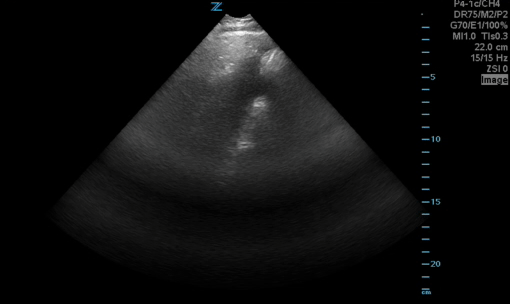A middle aged male s/p TURBT (transurethral resection of bladder tumor) 1 day ago presented with lower abdominal pain and no urine output from his foley catheter. A bladder scan was performed which was ~ 50 cc. What's the dx?
Vitals: T 98.7 HR 110 BP 117/70 RR 18 O2 98% on RA

Answer and Learning Point
Answer
The image above is of Morrison's pouch, demonstrating significant free fluid within the peritoneal cavity. Given the recent TURBT and lack of urinary output from the patient's foley catheter, this suggests that the fluid identified is consistent with urine secondary to intraperitoneal bladder perforation. This was later confirmed by CT cystogram and shortly after the patient was taken to the operating room for definitive repair.
Learning Points
-
- Bladder perforation from TURBT is relatively rare with an incidence of clinically significant perforations of 1.3%. Furthermore, intraperitoneal bladder perforation only accounts for ~17% of these, making it quite uncommon [1]. A small number of intraperitoneal bladder perforations are also associated with small bowel or colon injury [2].
- While around 30% of bladder ruptures from TURBT are detected intraoperatively, the remainder present postoperatively (mean time to diagnosis of 6 days) with lower abdominal pain and/or decreased urine output [2].
- CT cystogram is the gold standard for diagnosis of bladder perforation and can provide information on location of the perforation as well as whether it is intraperitoneal or extraperitoneal [3].
- As demonstrated in the case above, ultrasound can be used as an imaging adjunct at the bedside to rapidly detect intraperitoneal fluid to expedite consultation with urologic services and definitive CT imaging.
- The treatment of extraperitoneal perforation of the bladder is usually conservative via prolonged foley catheter drainage. For intraperitoneal lesions, open-surgical exploration and repair is recommended [1-2].
- Emergency department management of these patients should consist of rapid diagnosis, broad spectrum antibiotic therapy, fluid resuscitation as needed, and urgent urological consultation.
Author
This post was written by Michael Macias, MD, Ultrasound Fellow at UCSD.
References
-
- Rausch S, e. (2017). [Transurethral resection of bladder tumors: management of complications]. - PubMed - NCBI . Ncbi.nlm.nih.gov. Retrieved 2 September 2017, from https://www.ncbi.nlm.nih.gov/pubmed/?term=24806801
- Golan S, e. (2017). Transurethral resection of bladder tumour complicated by perforation requiring open surgical repair - clinical characteristics and oncological outc... - PubMed - NCBI . Ncbi.nlm.nih.gov. Retrieved 2 September 2017, from https://www.ncbi.nlm.nih.gov/pubmed/20860654
- COMPLICATIONS OF TRANSURETHRAL RESECTION OF BLADDER TUMORS. Eric A. Singer MD, MA and Ganesh S. Palapattu MD. Complications of Urologic Surgery: Prevention and Management, Chapter 25, 295-302

